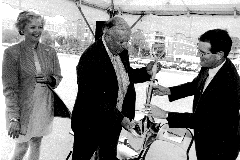
 |
New Stadium Pavilion
A once-injured athlete |
 Elaine and Wayne Schelle believe they owe a lot to
Hopkins.
Elaine and Wayne Schelle believe they owe a lot to
Hopkins.The couple met after Wayne severely injured his leg playing football on Homewood Field for the Blue Jays in 1954. He spent nine months in Johns Hopkins Hospital recuperating from the injury that shattered his leg; a variety of infections left him in critical condition a few times during his recovery. Elaine was a student at the School of Nursing at the time. Years later, the two were traveling in Europe when they encountered a disabled Frenchman who assumed Wayne's limp was the result of a war wound. "Where did you get yours, Normandy?" the man asked. "No," Wayne replied. "Homewood." The couple returned to the scene of that injury earlier this month to help celebrate the groundbreaking for the future pavilion, which will include permanent seating for 5,000 on the visitors' side of the field and an entrance plaza. For the past several years, thousands of sports fans have been seated in temporary wooden bleachers on the north side of the arena. After his injury, Wayne Schelle, a business and industrial management major, returned to the Homewood campus and became manager of the Blue Jays baseball team. Since then, the erstwhile athlete has remained an avid Hopkins fan. The Schelles have pledged $3 million to the university, to be divided evenly between the pavilion project, a student recreation center and the distance learning center of the School of Nursing, Elaine's alma mater. "Life is about making things better," Wayne Schelle said. "I think this will."
Despite Budnitz's lofty concept of Homewood Field, Schelle said the decision to support the project "did not take a lot of vision." "When I was 18, I knew that half of the stadium was missing," he said. Built in 1906, the stadium is the home of Hopkins football, lacrosse, field hockey, track and field, and soccer teams. The original grandstands were added in 1908 and 1910. In 1965, the center section with the press box connected the two seating sections. Also in 1965, the Newton H. White Jr. Athletic Center was completed, and in 1967 the concrete grandstand on the home side of the field was dedicated to former Hopkins band leader Conrad Gebelein. In 1998 Hopkins will host the World Lacrosse games; the next year, the women's NCAA Division I Lacrosse Championships will be played there. The new northside pavilion will be named in honor of the Schelles. Director of Athletics Tom Calder said the improvements to Homewood Field are an indication of the university's commitment to all student athletes and his staff. University President William R. Brody also cited the future student arts center, the renovation of the Homewood apartments on Charles Street and the acquisition of the future interfaith center (see story on Wilson Building acquisition), also on Charles Street, as projects that demonstrate that commitment. "We clearly have the best and brightest students anywhere," Brody said at the kickoff event. "At the same time, we understand that an important part of the undergraduate experience takes place outside the classroom." Preliminary construction work is set to begin by the end of the summer; the pavilion is scheduled to be completed before the men's lacrosse team opens its season in February.
Go back to Previous Page
|